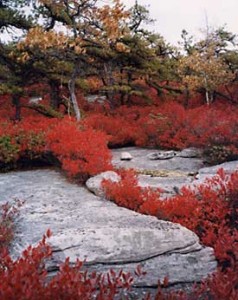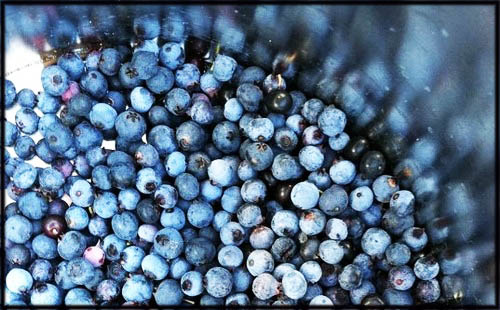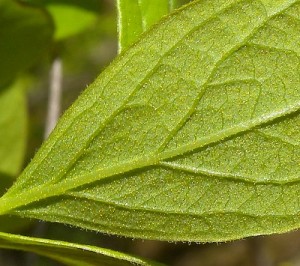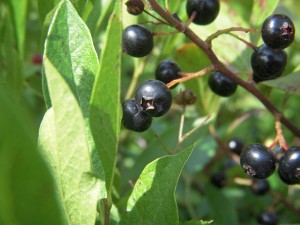
Wild huckleberries — red-leaved in autumn — grow in arid places in the east. They’re ripe in mid-July.
Huckleberries. Little black cousins of the blueberry, fruit of the forest. It’s mid-July in New York, and the huckleberries are ripe, and they’re out there. You just have to go get them, and put in the hours it takes to fill your basket.
New York State’s forests are so full of ripe huckleberries (and blueberries) at the moment, it would be difficult to take a hike in Harriman State Park and not find them.
And it’s a bumper year. No late frosts, plenty of rainfall and sunshine.
But there’s a little investigating to be done first.
Huckleberries: What to Look For
The New York State huckleberry is the Gaylussacia baccata, or black huckleberry. It is distinct from the huckleberries of the west, which are related to the blueberry.
The leaves closely resemble the blueberry plant’s. They are green oval-oblong, and covered with tiny glittering resin dots on the underside. The plants grow from 1-3 feet. Your huckleberry will grow only on the current year’s growth, so there’s no need to tunnel deep into the bush. Everything you want is on the outside of the plant.
Unlike the blueberry, the huckleberry is a shiny black. In Harriman State Park, they ripen a week or two (sometimes more) after the blueberries are ready.
Where to Find Huckleberries in Harriman and Beyond:
Huckleberries grown anywhere blueberries grow, and in Harriman, that is basically anywhere: by the side of the road, on mountaintops and balds, in low grassy areas. They like fire-prone areas (they love ash) and will grow in gaps in the tree cover.
They may grow in shady areas, but their fruit will fail to develop there.
Some of the best places to pick huckleberries may be found by researching the places where the berries were historically gathered by “berrypicker” communities. Pickers traveled from the New York City area to the mountains and ridges near Harriman, the Shawangunks, and the Catskill foothills to live and pick for the New York market.
Here’s a hint. I’ve used the old New York Times article (PDF download below) to find locations for the best huckleberry fields in the state. The area they are pretty stoked about appears to be the Sundown Wild Forest area, in the southern Catskills.
Here’s another hint. One of the best huckleberry and blueberry fields I’ve found in Harriman is at the southern tip of Lake Welch. There’s a grassy spot nearby. You’ll know it when you find it! (I told you it was a hint.)
More Huckleberry Facts:
- Yes, you can pick fruit in New York State parks, according to NYCRR, Part 190:
“No person shall deface, remove, destroy or otherwise injure in any manner whatsoever any tree, flower, shrub, fern, fungi or other plant organisms…found or growing on State land, except for personal consumption….” - Huckleberry bushes look so much like highbush blueberries, it’s hard to tell them apart.
- You can actually buy something called a berry rake, that pulls down the berries, gently, from the shrub and deposits them in a bucket. There are a couple models available from Amazon.com. But, I don’t know. That seems like an unfair advantage over the bear, and if it’s not done right, you can damage the bush.
- Speaking of bears, huckleberries (and blueberries) are a favorite food. You might find yourself sharing the patch with a black bear. But your bigger worry would be…
- Snakes. Huckleberries grow abundantly on dry, rocky soil, places beloved by snakes; in dry area, huckleberries may attract the field mice that snakes feed on. Watch out for snakes in these parts (especially if you’re going to the famed berry patches of the ‘Gunks or Kingston County).
- We don’t know why, but you can’t just dig up the wild plants and put them in your garden for your own berry harvest. They won’t grow that way.
- You can’t buy a gigundo bag of them at Costco for $10.00. These babies are wild, man.
An undated article in the New York Times, from the height of huckleberry prosperity, discloses the historic location of the “largest and richest berries”: it’s in High Point, a spur of the Shawangunk Mountains between the towns of Olive and Rochester, New York:
“This high mountain juts out from the rest of the Shawangunk chain, and rises solitary in the midst of a level plain….it is clothed with blueberry bushes to its very top. Here the great luscious huckleberries grow on their heather-like stems larger and more juicy than in any other place.”
I was, however, surprised to read further that the way the huckleberries were harvested was gathered:
“They are gathered by pulling the stalks up by the roots and stripping off berries and leaves until the pails are full.”
What???
Source: Download The New York Times’ vintage huckleberry article.






Thank you Suzy for sharing your knowledge of the Harriman berries.
I too look forward to this time of year when the berries begin to ripen. I went up early this morning to pick blueberries, and on the way, stopped at the lake Welch site that you had recommended. The lake Welch parking lot was not open, and so I was anxious to get back to my car which I had left parked alongside Gatehill Rd. However, I did manage to find a lone highbush bearing fruit but left without picking. This area would be problematic for me to pick because of the parking issue. I suppose you can take your chances and park by the side of the road, but as you know, it IS illegal.
Anyway, you are absolutely correct about this being a bumper crop year. It’s been years since I’ve seen so many berries already ripen this early, with many more green ones ready to mature. I imagine I will pick at least several gallons of the stuff when all is said and done. Great job on the huckleberry article…much appreciated.
Hi, John. Several gallons is a lot! I appreciate the perspective — I knew last year was poor for berries, but thought maybe it was an exceptionally bad year. (By the way, I was looking for huckleberries to purchase online, and found them for $80.00 a gallon — frozen, too.)
We park close to the end of St. John’s Road, where it comes off of Gate Hill, then walk across Gate Hill Road and onto the little chained-off road that leads to the boat launch. The whole area to the right, between that little spur road and the southern end of Lake Welch, must have, at one time, been someone’s property, and they’ve planted highbush blueberries and huckleberries all over the place. They’ve also planted concord grapes and elderberries that have grown up as well.
We picked two bags of berries before heading off to Breakneck Pond (there are more there, too). We topped everything off with the red raspberries in Rockefeller State Park in Tarrytown, and had enough for two berry pies.
Thanks for posting a comment, too. You’re the first (that hasn’t been about improving my SEO!) Happy picking!
“We don’t know why, but you can’t just dig up the wild plants and put them in your garden for your own berry harvest. They won’t grow that way” Mystery solved! The branch that grows above the ground is not the plant, but only a shoot. The plant is the rhizome that spreads beneath the ground and cannot be easily propagated. Other common plants that use vegetative reproduction with rhizomes are bamboo, hops, asparagus, ginger and irises. This also explains why pulling up the shoot and stripping the fruit does not kill the plant (but I wouldn’t recommend it; others might strike you dead with their looks).
Hey, that’s great to know, Tom. Thanks! I was amazed at how many widespread the huckleberry bushes are in the old berry communities, especially since they ripped them right out. Mystery solved!
I would like to buy some huckleberries. I live in southern Maryland and I can’t find any here. As children,
my two sisters and I use to pick them from the woods near the farm in Henrico, Virginia. However, all the
plants there were destroyed by Highway 64 quite a few years ago. Help, Marion
I have missed huckleberry and elderberry pies since our family moved to North Carolina in 1966. I’ve only been “home” to upstate NY a handful of times. I am planning to be in upstate next year (July or August of 2017) and would like to purchase canned berries. Any suggestions by you or your readers such as farmers markets or fruit stands, would be very much appreciated.
Great post. I know this is years late: But how did you hone in on that NYCRR rule? I would love to find the source